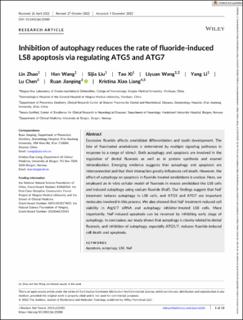| dc.contributor.author | Zhao, Lin | |
| dc.contributor.author | Wang, Han | |
| dc.contributor.author | Liu, Sijia | |
| dc.contributor.author | Xi, Tao | |
| dc.contributor.author | Wang, Liyuan | |
| dc.contributor.author | Li, Yang | |
| dc.contributor.author | Chen, Lu | |
| dc.contributor.author | Jianping, Ruan | |
| dc.contributor.author | Liang, Xiao | |
| dc.date.accessioned | 2023-02-01T10:06:16Z | |
| dc.date.available | 2023-02-01T10:06:16Z | |
| dc.date.created | 2023-01-09T15:14:04Z | |
| dc.date.issued | 2022 | |
| dc.identifier.issn | 1095-6670 | |
| dc.identifier.uri | https://hdl.handle.net/11250/3047670 | |
| dc.description.abstract | Excessive fluoride affects ameloblast differentiation and tooth development. The fate of fluorinated ameloblasts is determined by multiple signaling pathways in response to a range of stimuli. Both autophagy and apoptosis are involved in the regulation of dental fluorosis as well as in protein synthesis and enamel mineralization. Emerging evidence suggests that autophagy and apoptosis are interconnected and that their interaction greatly influences cell death. However, the effect of autophagy on apoptosis in fluoride-treated ameloblasts is unclear. Here, we employed an in vitro cellular model of fluorosis in mouse ameloblast-like LS8 cells and induced autophagy using sodium fluoride (NaF). Our findings suggest that NaF treatment induces autophagy in LS8 cells, and ATG5 and ATG7 are important molecules involved in this process. We also showed that NaF treatment reduced cell viability in Atg5/7 siRNA and autophagy inhibitor-treated LS8 cells. More importantly, NaF-induced apoptosis can be reversed by inhibiting early stage of autophagy. In conclusion, our study shows that autophagy is closely related to dental fluorosis, and inhibition of autophagy, especially ATG5/7, reduces fluoride-induced cell death and apoptosis. | en_US |
| dc.language.iso | eng | en_US |
| dc.publisher | Wiley | en_US |
| dc.rights | Navngivelse-Ikkekommersiell 4.0 Internasjonal | * |
| dc.rights.uri | http://creativecommons.org/licenses/by-nc/4.0/deed.no | * |
| dc.title | Inhibition of autophagy reduces the rate of fluoride-induced LS8 apoptosis via regulating ATG5 and ATG7 | en_US |
| dc.type | Journal article | en_US |
| dc.type | Peer reviewed | en_US |
| dc.description.version | publishedVersion | en_US |
| dc.rights.holder | Copyright 2022 the authors | en_US |
| dc.source.articlenumber | e23280 | en_US |
| cristin.ispublished | true | |
| cristin.fulltext | original | |
| cristin.qualitycode | 1 | |
| dc.identifier.doi | 10.1002/jbt.23280 | |
| dc.identifier.cristin | 2103481 | |
| dc.source.journal | Journal of biochemical and molecular toxicology | en_US |
| dc.identifier.citation | Journal of biochemical and molecular toxicology. 2022, e23280. | en_US |

